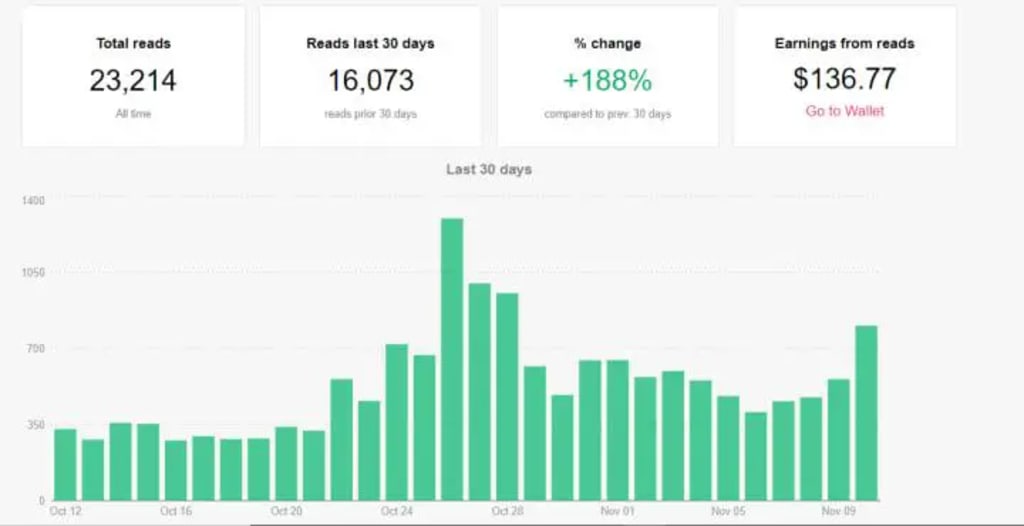50 SEO tips for writers to get more traffic to your posts
Get more reads- Follow this seo tips

50 SEO tips for articles to help you increase visibility and get more views:
1. **Keyword Research:**
Before creating content, conduct thorough keyword research to identify the terms and phrases your target audience is searching for. Tools like Google Keyword Planner and SEMrush can assist in finding relevant keywords with search volume data.
2. **Long-Tail Keywords:**
Long-tail keywords are more specific phrases that cater to a niche audience. They often have less competition and can bring in highly targeted traffic. For example, instead of targeting "weight loss," consider "healthy weight loss tips for beginners."
3. **Title Optimization:**
Craft a compelling title that not only includes your primary keyword but also entices users to click. It should succinctly summarize what the article is about while sparking curiosity.
4. **Meta Descriptions:**
The meta description is a brief summary that appears in search results. Make it engaging, under 160 characters, and include a call-to-action to encourage clicks. It should accurately represent the content.
5. **URL Structure:**
Keep your URL short, meaningful, and include your target keyword if possible. A clean URL structure improves user experience and search engine readability.
6. **Header Tags:**
Use header tags (H1, H2, H3) to structure your content hierarchically. The H1 tag should contain the main title, while H2 and H3 tags organize subheadings and subsections.
7. **Mobile Optimization:**
With a significant portion of internet users accessing content on mobile devices, ensure your website and articles are mobile-friendly. This involves responsive design and easy navigation on smaller screens.
8. **Page Loading Speed:**
Page speed is a crucial ranking factor. Optimize images, leverage browser caching, and use a Content Delivery Network (CDN) to enhance loading times. Google's PageSpeed Insights can help identify areas for improvement.
9. **Image Optimization:**
Compress images to reduce file sizes without compromising quality. Use descriptive file names and alt text, as search engines can't "see" images but rely on these elements for context.
10. **Internal Linking:**
Linking to other relevant pages on your website helps search engines understand your site's structure. It also keeps users engaged by providing additional valuable information.
11. **External Linking:**
Linking to authoritative external sources adds credibility to your content. It demonstrates that your information is well-researched and contributes to the overall user experience.
12. **Social Media Integration:**
Sharing your articles on social media platforms not only increases visibility but also drives traffic. Craft engaging posts with a call-to-action and appropriate hashtags.
13. **Content Length:**
While there's no fixed rule, longer articles often perform better in search results. Aim for comprehensive coverage of your topic, providing value to your audience.
14. **Quality Content:**
Content quality is paramount. Focus on creating informative, well-researched, and engaging content that addresses the needs and interests of your target audience.
15. **Keyword Placement:**
Integrate keywords naturally throughout your content. Avoid overusing them, as this can be perceived as spammy. Prioritize a smooth reading experience for users.
16. **User Intent:**
Understand what users are searching for and tailor your content to fulfill those needs. Google's algorithms increasingly prioritize content that aligns with user intent.
17. **Schema Markup:**
Schema markup provides additional information to search engines about the context of your content. Implementing schema can enhance how your content appears in search results, potentially increasing click-through rates.
18. **Voice Search Optimization:**
Voice searches often use more conversational language. Optimize your content to answer common voice queries and provide information in a natural, conversational tone.
19. **Local SEO:**
If your business has a local presence, optimize for local search by incorporating location-specific keywords. This is crucial for attracting nearby customers.
20. **User Engagement:**
Encourage user engagement through comments, social shares, and likes. This not only indicates content value but can also contribute to higher search rankings.
21. **Video Integration:**
Embedding relevant videos enriches the multimedia experience for your audience. It can increase time spent on your page, a factor search engines consider in rankings.
22. **Google My Business:**
If your business has a physical location, claim and optimize your Google My Business listing. This enhances your visibility in local search results, especially for users looking for nearby services.
23. **Update Old Content:**
Periodically revisit and update older content to keep it relevant. Add new information, update statistics, and refresh the content to reflect any changes in your industry.
24. **Social Proof:**
Showcase social proof like testimonials, reviews, and endorsements. This builds trust with your audience and can positively impact both user engagement and search rankings.
25. **Email Marketing:**
Use email newsletters to promote your articles to your subscriber base. Email remains a powerful tool for driving traffic to your content.
26. **Influencer Collaboration:**
Collaborating with influencers in your niche can extend your reach. Influencers often have dedicated followers who trust their recommendations.
27. **Guest Posting:**
Contribute guest posts to authoritative websites in your industry. This not only helps build backlinks but also exposes your content to a new audience.
28. **Readability:**
Enhance readability by using short paragraphs, bullet points, and subheadings. This makes your content more accessible and enjoyable for readers.
29. **FAQs:**
Including a frequently asked questions (FAQs) section addresses common queries and provides a valuable resource for users. It can also contribute to featured snippets in search results.
30. **Social Sharing Buttons:**
Add social sharing buttons to make it easy for readers to share your content on their preferred social media platforms. This can amplify your content's reach.
31. **Monitor Analytics:**
Regularly analyze website analytics using tools like Google Analytics. Understand which pages are performing well, track user behavior, and use insights to refine your SEO strategy.
32. **Competitor Analysis:**
Keep an eye on your competitors. Analyze their successful strategies, identify gaps, and find opportunities to differentiate your content.
33. **SSL Certificate:**
Secure your website with an SSL certificate. Besides enhancing security, Google considers HTTPS as a ranking factor, giving your site a potential SEO boost.
34. **Breadcrumb Navigation:**
Implement breadcrumb navigation for better user experience. This helps users understand the structure of your site and navigate more efficiently.
35. **ALT Tags for Images:**
Use descriptive ALT tags for images. This not only aids accessibility for visually impaired users but also provides context for search engines.
36. **Avoid Duplicate Content:**
Duplicate content can harm your SEO. Ensure each page on your site has unique content to avoid penalties and maintain a positive search ranking.
37. **Structured Data:**
Implement structured data markup (schema.org) to provide additional information to search engines. This can result in rich snippets, improving your content's visibility in search results.
38. **Social Proof:**
Leverage social proof to build trust. This can include testimonials, reviews, and endorsements from satisfied customers or influencers in your industry.
39. **User-Generated Content:**
Encourage users to contribute content through comments, reviews, or discussions. User-generated content adds authenticity and can positively impact
40. **Semantic SEO:**
Semantic SEO involves using related terms and concepts to provide a more comprehensive understanding of your content to search engines. Instead of focusing solely on exact keyword matches, consider synonyms and context to improve relevance.
41. **Link Building:**
Link building is the process of acquiring high-quality backlinks from other websites. These links act as endorsements, signaling to search engines that your content is valuable. Outreach, partnerships, and creating shareable content are common link-building strategies.
42. **Evergreen Content:**
Evergreen content is timeless and remains relevant over an extended period. Creating such content ensures a steady flow of traffic as it continues to address the needs and interests of your audience.
43. **Google Search Console:**
Google Search Console is a powerful tool for monitoring your website's performance in Google search results. It provides valuable insights into search queries, indexing status, and potential issues that may affect your site's visibility.
44. **Content Syndication:**
Content syndication involves republishing your content on third-party platforms to reach a broader audience. Choose reputable platforms that align with your niche to maximize exposure.
45. **Social Bookmarking:**
Social bookmarking involves sharing your articles on platforms like Reddit, StumbleUpon, or Digg. This can increase visibility and drive traffic, especially if your content resonates with the platform's community.
46. **Niche Forums:**
Engaging in niche forums and communities related to your industry allows you to share your expertise and build a presence. Include links to your content when relevant, but focus on providing value to the community.
47. **Link Reclamation:**
Link reclamation involves identifying instances where your brand or content is mentioned but not linked. Reach out to website owners and request a link, which can help improve your backlink profile.
48. **Anchor Text Optimization:**
When linking internally or externally, optimize anchor text by using relevant keywords. This provides additional context to search engines about the linked content.
49. **User Reviews:**
Encourage and showcase user reviews on your site. Positive reviews contribute to a positive online reputation, and search engines may consider user-generated content when determining relevance and trustworthiness.
50. **Consistent Publishing Schedule:**
Maintaining a consistent publishing schedule signals to both users and search engines that your website is active and regularly updated. Consistency fosters audience engagement and can positively impact search rankings.
By incorporating these detailed SEO tips into your content strategy, you'll be better equipped to optimize your articles for search engines and attract a larger and more engaged audience. Keep in mind that SEO is an ongoing process, and adapting to evolving trends and algorithms is crucial for sustained success.
About the Creator
Salman siddique
Hello Everyone!
I write interesting stories
Enjoyed the story? Support the Creator.
Subscribe for free to receive all their stories in your feed. You could also pledge your support or give them a one-off tip, letting them know you appreciate their work.






Comments
There are no comments for this story
Be the first to respond and start the conversation.